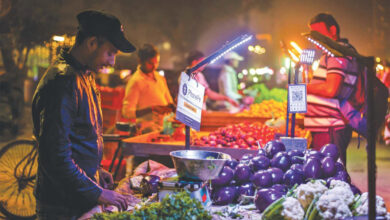India’s Interim Budget Will Have Spillover Effects on South Asian Economy
Overall, interim budget has given a clear cut direction for India's growth and development towards the Viksit Bharat by 2047.

India’s interim budget focus on poor, youth, farmers and women will not only uplift more than 60 percent of the population in India but also have a spillover effect in South Asia. It sets an example for the developing countries to uplift the downtrodden, facilitate the youth, farmers and empower the women. Overall, it will have a positive impact on more than 10 percent of the world population. India’s Interim Budget 2024-25 stands as a pivotal blueprint for driving accelerated development and shaping the nation’s economic landscape. Designed with foresight and a commitment to inclusivity, this budget is not merely a financial plan but a strategic roadmap for India’s transformation towards a developed economy. The budget places a significant emphasis on inclusive growth, social empowerment, and infrastructure development, reflecting a comprehensive approach towards addressing socio-economic challenges and fostering sustainable progress. From strategic initiatives to tax stability and support for the private sector, the Interim Budget aims to propel India towards a brighter economic future, laying the groundwork for prosperity and inclusive development.
The Interim Budget projects a fiscal deficit of 5.1% of GDP, signaling a disciplined approach to financial management. This reduction is expected to attract substantial foreign direct investment (FDI) and position India as a robust destination for global investment inflows. Aligned with the vision of Viksit Bharat by 2047, the budget prioritizes fiscal consolidation, targeting a further reduction of the fiscal deficit to 4.5% in the fiscal year 2025-26. This strategic fiscal approach sets the stage for sustainable economic growth and macroeconomic stability.
Rising Capital Expenditure in India
Source: Compiled from Union Budget 2024-25, Government of India Infrastructure development remains a top priority, with an 11.1% increase in Capital Expenditure (Capex), reaching Rs. 11,11,111 crore for the next fiscal year. This substantial investment is anticipated not only to create state-of-the-art infrastructure but also to stimulate aggregate demand in the country, generating employment opportunities across skill levels. The government’s continued focus on infrastructure is a crucial driver for economic growth, enhancing logistics efficiency and reducing operational costs.
The government’s targeted focus on empowering underprivileged communities, youth, farmers, and women is a cornerstone of the budget. By increasing capital expenditure and introducing sector-specific initiatives, the government aims to make economic growth more inclusive and job-oriented. India’s interim budget focus on poor, youth, farmers and women will not only uplift more than 60 percent of the population in India but also have a spillover effect in South Asia. It sets an example for the developing countries to uplift the downtrodden, facilitate the youth, farmers and empower the women. Overall, it will have a positive impact on more than 10 percent of the World population. India accounts for about three-fourths of South Asian Region output.
The focus of government spending towards infrastructure investment, consolidated labor regulations, privatizing underperforming state-owned assets, and modernizing and integrating the logistics sector will have positive spillovers on the whole South Asian Region for investors’ attraction and to enhance the intra-regional trade as there are many trade complementarities between India- Bangladesh, India- Sri Lanka, India-Nepal and India- Bhutan. The growing intra-regional trade between these economies will bring lot of prosperity with enhanced opportunities for employment for youth, women empowerment, farm technologies and improved living standards.
The total expenditure for the fiscal year 2024-25 is estimated at Rs. 47.6 lakh crore, with a fiscal deficit of Rs. 16.8 lakh crore. This significant allocation reflects a commitment to address socio-economic disparities and enhance the overall well-being of the population.
The announcement of major economic corridors like the India Middle East Europe Economic Corridor, highlight a comprehensive approach to catalyzing infrastructure, and overall economic development. The budget’s transformative measures are poised to propel India towards a sustainable green economy, addressing multidimensional poverty and fostering inclusive development.
The budget emphasizes three significant economic railway corridor programs, targeting energy, mineral, and cements corridors, port connectivity corridors, and high traffic density corridors. Initiatives like the decongestion of high-density rail corridors and the conversion of train bogies into high-speed ones contribute to the modernization of the rail network are expected to foster economic expansion and strengthen the overall economy.
Strategic allocations in the budget focus on social welfare and healthcare expansion. Initiatives like PM Schools for Rising India, Skill India Mission, and healthcare expansions under Ayushman Bharat showcase a commitment to holistic development, education, and public health, leading to enhanced human development. The allocation of interest-free loans to states for tourism promotion underscores a commendable effort towards boosting the tourism sector and enhancing regional connectivity. The allocation of interest-free loans to states for tourism promotion and the development of Lakshadweep is a commendable step towards boosting the tourism sector. The success and expansion of the Udan Scheme further enhance regional connectivity, emphasizing the importance of air connectivity in driving economic growth.
Substantial increase in FY2024-25 expenditure budget for disbursements under PLI schemes (covering EVs, auto components, and air conditioners) indicates successful grounding of investment proposals. The PLI scheme has significantly boosted the trajectory of manufactured production and exports, which is visible from the growth of the manufacturing and growth of exports.
Initiatives such as establishing coal gasification and liquefaction capacity, integrating e-buses into the public transport network, fortifying the e-vehicle ecosystem through support for manufacturing and charging infrastructure, and promoting climate-resilient activities for a Blue Economy 2.0 are also part of the comprehensive approach towards a more sustainable and eco-friendly future. The budget reflects a forward-looking approach by focusing on green and renewable energy sources and integrating them into mainstream usage.
In the agriculture sector, the promotion of post-harvest investment and support for dairy farmers signal a proactive approach to agricultural growth. The government’s efforts to control diseases and provide crop insurance underscore its commitment to the welfare of the farming community. The extension of healthcare facilities under Ayushman Bharat to Asha and Anganwadi workers, coupled with plans to set up hospitals in all districts, demonstrates a dedication to improving healthcare accessibility. Additionally, the vaccination program for cervical cancer and the housing plan for the middle class contribute to holistic development.
Looking ahead to the full budget in July 2024, there are aspirations and hopes for relief in direct taxes to enhance the personal disposable income of the individuals. The enhanced personal disposable incomes in the hands of consumers will further strengthen the consumption trajectory and economic growth at the higher level. Overall, interim budget has given a clear cut direction for India’s growth and development towards the Viksit Bharat by 2047.




